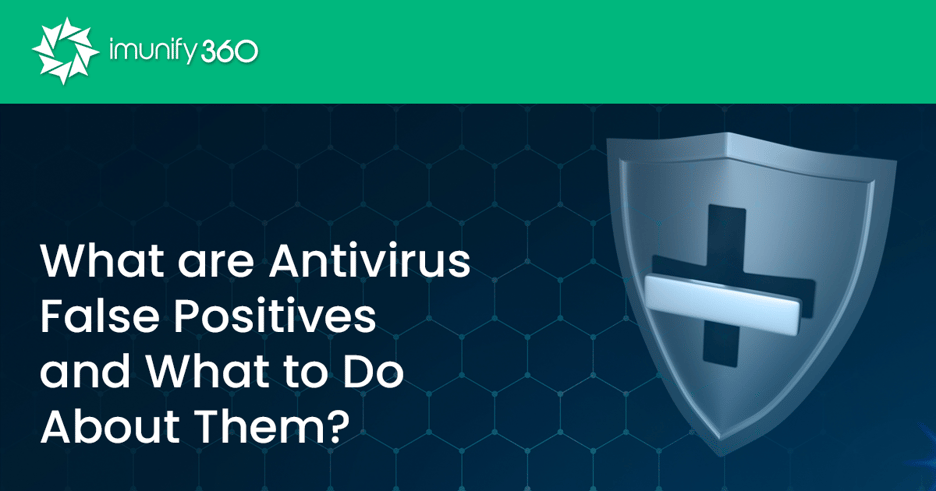What are Antivirus False Positives and What to Do About Them?

False positives from your monitoring applications can cause undue stress and unnecessary overhead for administrators if they do not have the security knowledge to identify them. If monitoring software reports inaccurate information, administrators unfamiliar with cybersecurity could make changes based on the application’s false positives that could harm the security and stability of the environment.
“Analyst burnout” also impacts security when too many false positives lead to an administrator ignoring potentially high-risk threats and suspicious behavior. In other words, if your analysts and administrators don’t trust the information shown in cybersecurity monitoring systems, then they may not act on critical ongoing attacks. This article covers the answers to this questions:
- What are False Positives?
- Why is it Essential to Stay on Top of False Positives
- How Can You Tell If a Virus is a False Positive?
- Recommended Articles
What are False Positives?
To make it easy for analysts to find issues, monitoring systems display real-time information so that they can understand current traffic patterns and act accordingly. Not every issue is an ongoing threat, but monitoring software speeds up the time it takes for administrators to act on any potential threat, which translates to less downtime and lowered costs to maintain the environment.
False positives send the wrong message to analysts. A false positive incorrectly tells an analyst that a threat that compromised the environment or an ongoing attack must be addressed. Note that it’s different from a false negative, which tells the analyst that nothing malicious was found on the network when a threat has access to the environment. Both scenarios cause overhead and lost time for administrators, but a false positive could lead to unnecessary configuration changes, investigations, and stress for anyone involved.
One goal for monitoring software is to limit false positives. Any analytics or monitoring application that cannot be trusted has unnecessary costs, but it also puts more overhead on administrators. They must investigate the issue, and they could make changes to the environment that could add risk. Administrators must be able to trust their monitoring solution so that they can make informed decisions on the way a network must be secured.
ClamAV, for example, is notorious for false positives. Free solutions tend to have a high false-positive rate, and the rules are created for people who are just learning to discover security vulnerabilities. These solutions could be sufficient for individuals and home networks, but free solutions do not have enterprise-level scanning and monitoring capabilities that support the detection of sophisticated attacks and new threats.
Why is it Essential to Stay on Top of False Positives?
When you research the topic of false positives and cybersecurity applications, the issue of analyst burnout is always the primary issue. When analysts don’t trust the application’s alerts and reports, it causes them to ignore warnings. Too many false positives create a stressful environment for administrators who must constantly investigate issues, knowing that many of them are being incorrectly reported.
Analyst burnout isn’t the only issue. For every alert, someone on the operations team must investigate it. If they go into an investigation looking for malware, it wastes the administrator’s time. Antivirus software that reports false negatives could delay the time it takes to resolve performance issues from CPU spikes and memory usage. In some cases, the issue could be the wrong malware alert, leaving the environment open to ongoing persistent threats, data loss, and non-compliance.
One critical issue coming from false positives and analyst burnout is that the effort made to focus on incorrect alerts takes away from legitimate concerns. This means that administrators could be focusing their attention on a false positive when an attacker has already breached the network. If an attacker can exploit monitoring software to send a false positive to their advantage, the monitoring software could leave an exploitable vulnerability that will cover malicious activity. As administrators focus on the false positive, attackers can exfiltrate data undetected.
The most damaging issue from false positives is when administrators no longer trust the application and ignore alerts. Even if administrators look into an alert, they might not review it thoroughly because they lost trust in the accuracy of the application. Too many false positives presented in a monitoring solution could have the “boy who cried wolf” scenario where administrators no longer take alerts seriously.
How Can You Tell If a Virus is a False Positive?
Administrators relying on their monitoring software entrust the application to give accurate information. IT administrators are not normally security experts, so they will struggle to identify a false positive from a legitimate alert. As more false positives are reported, administrators may lose trust in their antivirus software. There are some general ways to identify if the alert is a false positive, such as:
Search the application name. If you’re trying to install an application flagged as malicious by your antivirus software, search for the application name on Google. It’s likely that you’ll find more information on the application’s activity and if it contains malicious code.
Ensure that antivirus software is updated. If you don’t have the latest version of your antivirus application, including patches, you could be missing updates that remediate any false positive bugs. Also, false negatives could be an issue with outdated antivirus software, so make sure that you have the latest version installed.
Review information about the malware on the antivirus vendor’s site. Most vendors have a library of malware data with information about the methods used to install it on a local server and the malware’s activity once installed. The library also has details on what can be done to manually remove it, if possible, and the signs that the local device has been infected.
Look at the application’s digital signature. Legitimate software contains a digital signature from the developer. It’s one of many factors in malware detection. An application’s digital signature will show the developer vendor, the time the signature was created, and the encryption used (e.g., SHA256).
The above steps help identify a false positive, but it isn’t 100% foolproof. Sophisticated malicious applications pretend to be legitimate programs, and some attempt to disable antivirus applications. Many antivirus vendors will not have information available for zero-day malware, and their software does not normally have the ability to detect zero-day threats. It takes time for researchers to study and determine the best method of removal. If you do not have the ability to fully analyze malware, then you could mistakenly assume a false positive is harmless when it’s a zero-day threat that could cause damage to the environment.
Imunify360 has a reputation for few false positives, so you can forget about false positives and focus on issues that matter. The anti-malware application monitors your web servers, identifies issues with near-zero false positives, and will clean malware before it installs on the server removing much of the overhead for administrators.
For web hosts that support an unlimited number of sites on one server, the Imunify360 firewall integrates with the ModSecurity web application firewall rulesets to enhance its low false positive count and effectiveness. The Imunify360 team researches and analyzes new threats so that the anti-malware application detects them quickly after they are released, and the application detects these threats without reporting false positives.
Take your web hosting security to the next level with Imunify360 security suite. Imunify360 is a complete security suite with all components working together to keep your servers safe and running while you could focus on other business tasks. Imunify360 is a synergy of Antivirus for Linux Server, Firewall, WAF, PHP Security Layer, Patch Management, Domain Reputation with easy UI and advanced automation. Try Imunify360 free for 14 days and see results in just one week.
Recommended Articles
- 17 ways to improve your cPanel security
- Proactive vs. Reactive Security: 5 Tips for Proactive Cyber Security
- 15 security tips for Linux VPS Hosting
- Top 15 Plesk Server Security Best Practices to Protect Your Website
- Top 10 Web Hosting Security Best Practices
- What Are Your First Three Steps When Securing a Linux Server?
- What are steps to secure a Linux server?
- How to keep your website secure in 2021
- Shared Hosting Security Guide for 2021
- Ultimate Guide for DirectAdmin Security from Security Experts
- Security made easy with Imunify360
- WordPress Security Fundamentals: Ultimate Guide 2021
- ModSecurity Rules: How to Guide



 6 Layers of Protection
6 Layers of Protection





.png?width=115&height=115&name=pci-dss%20(1).png)
